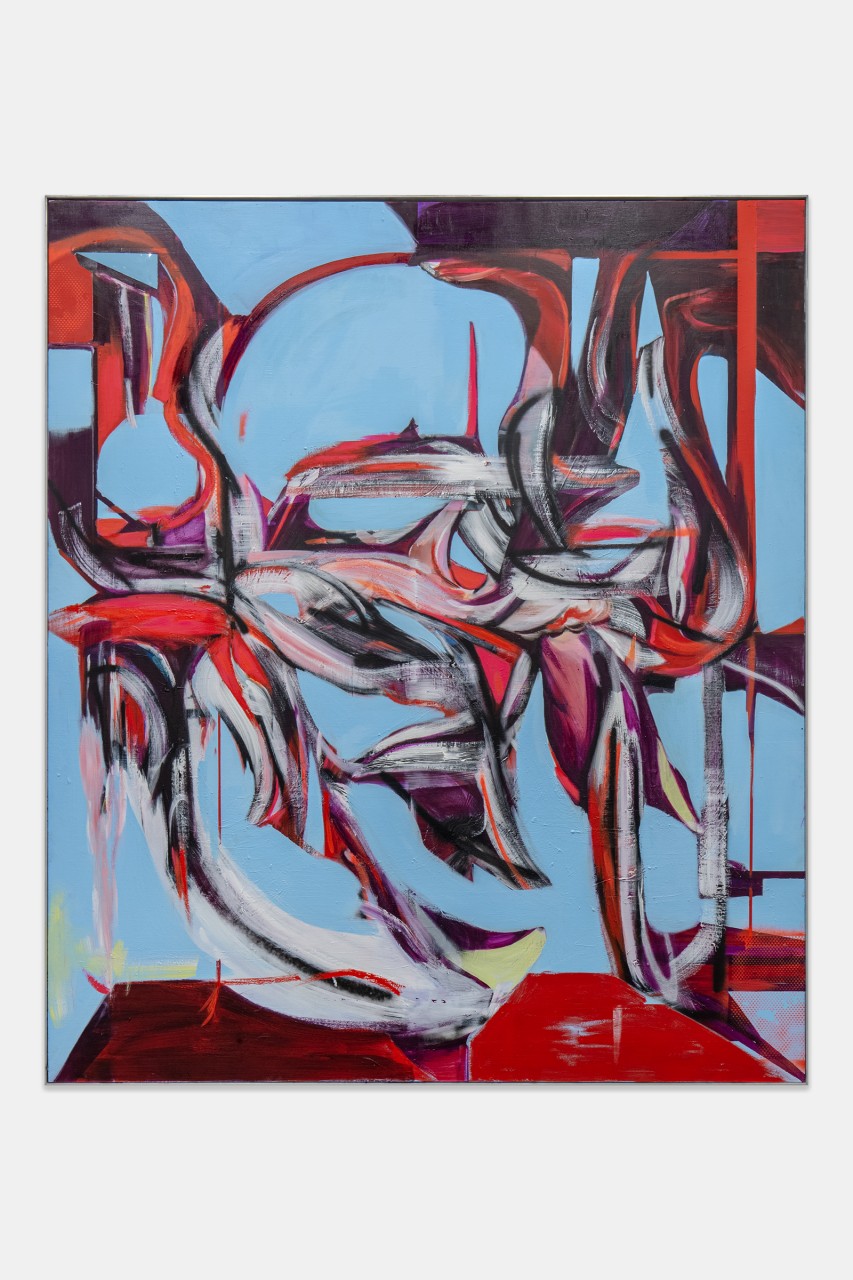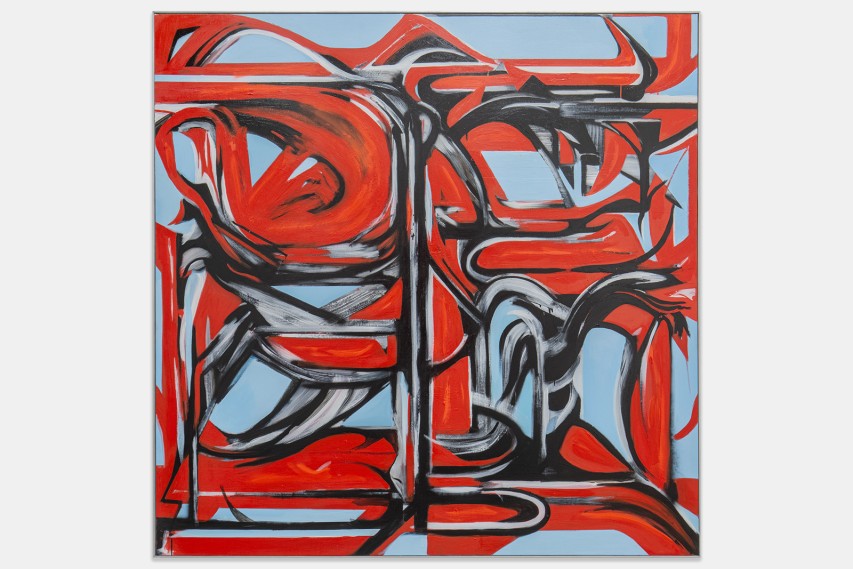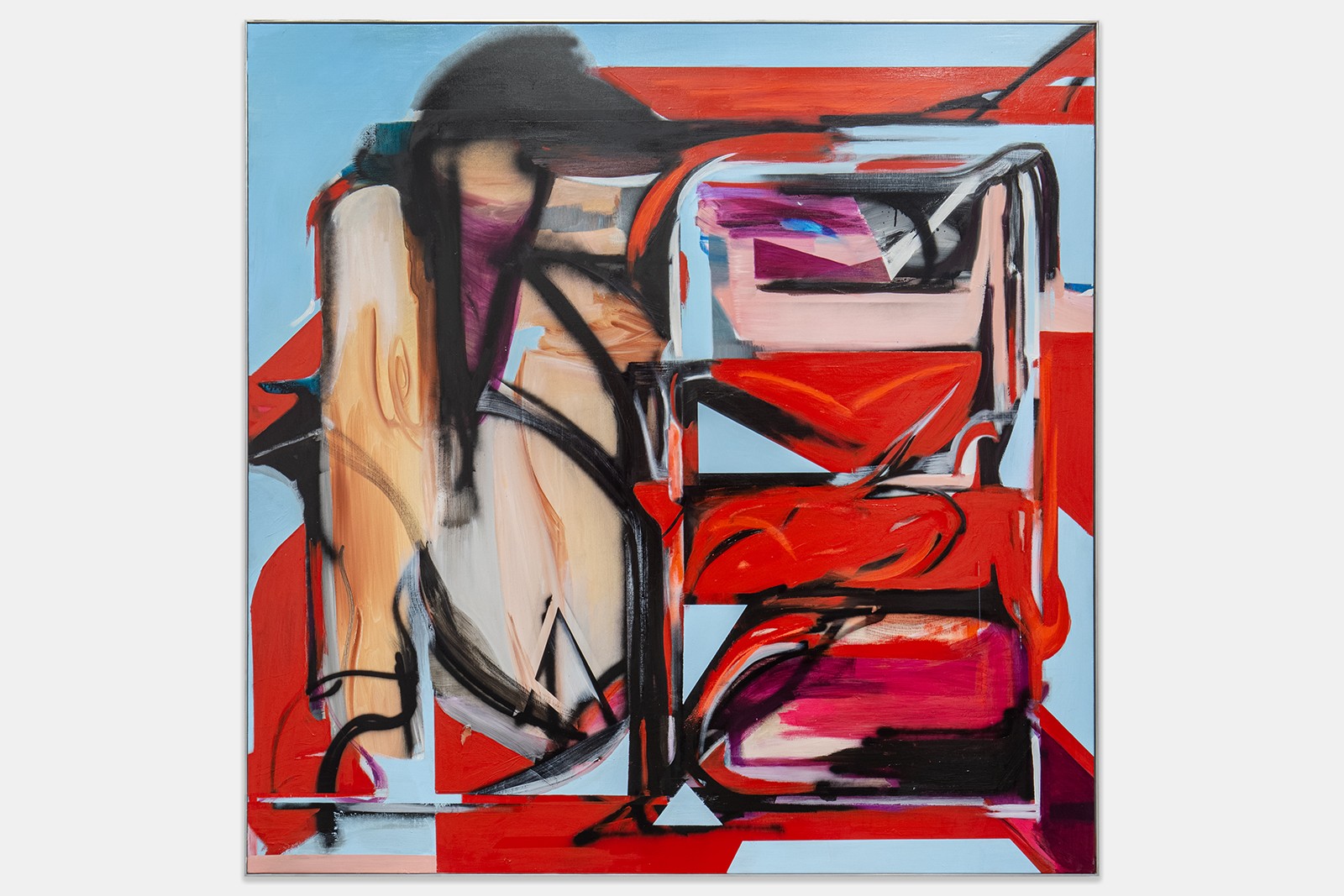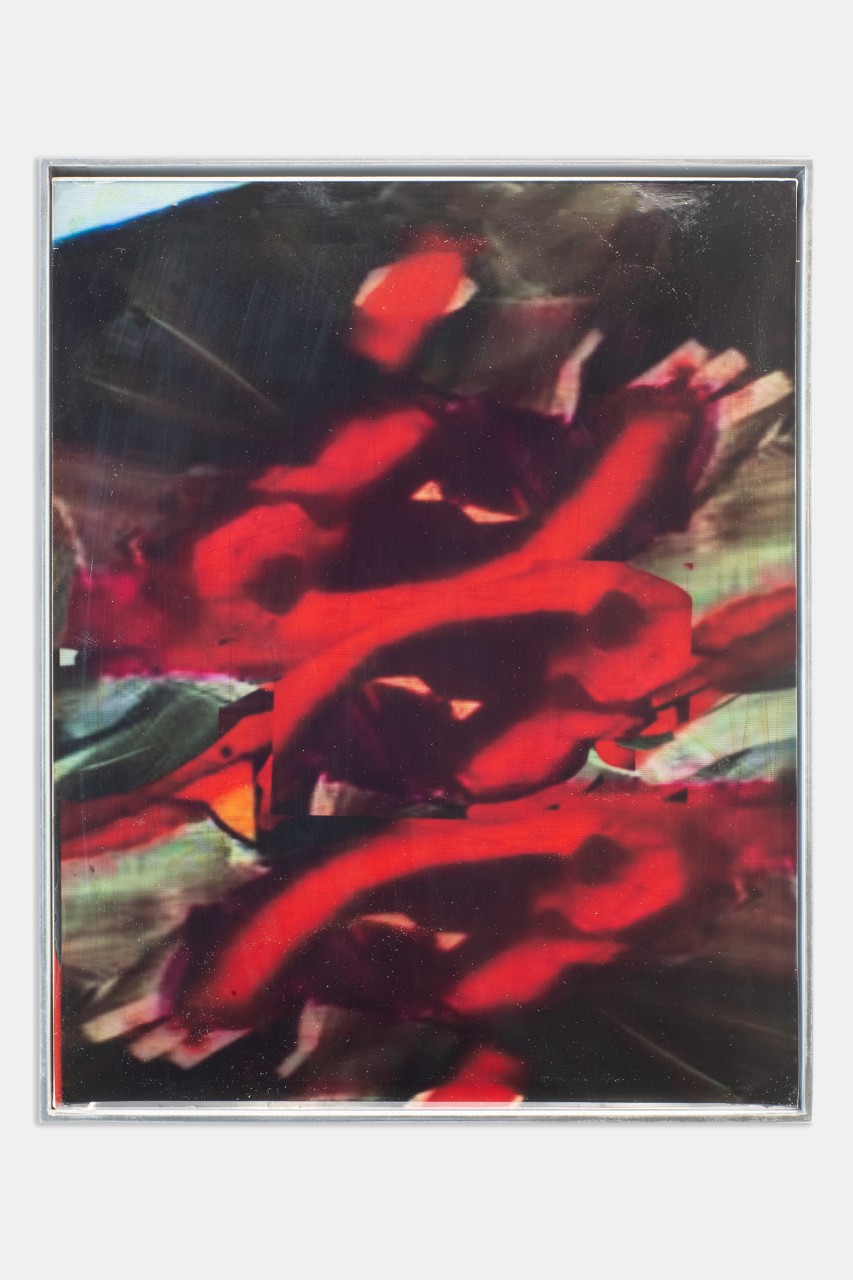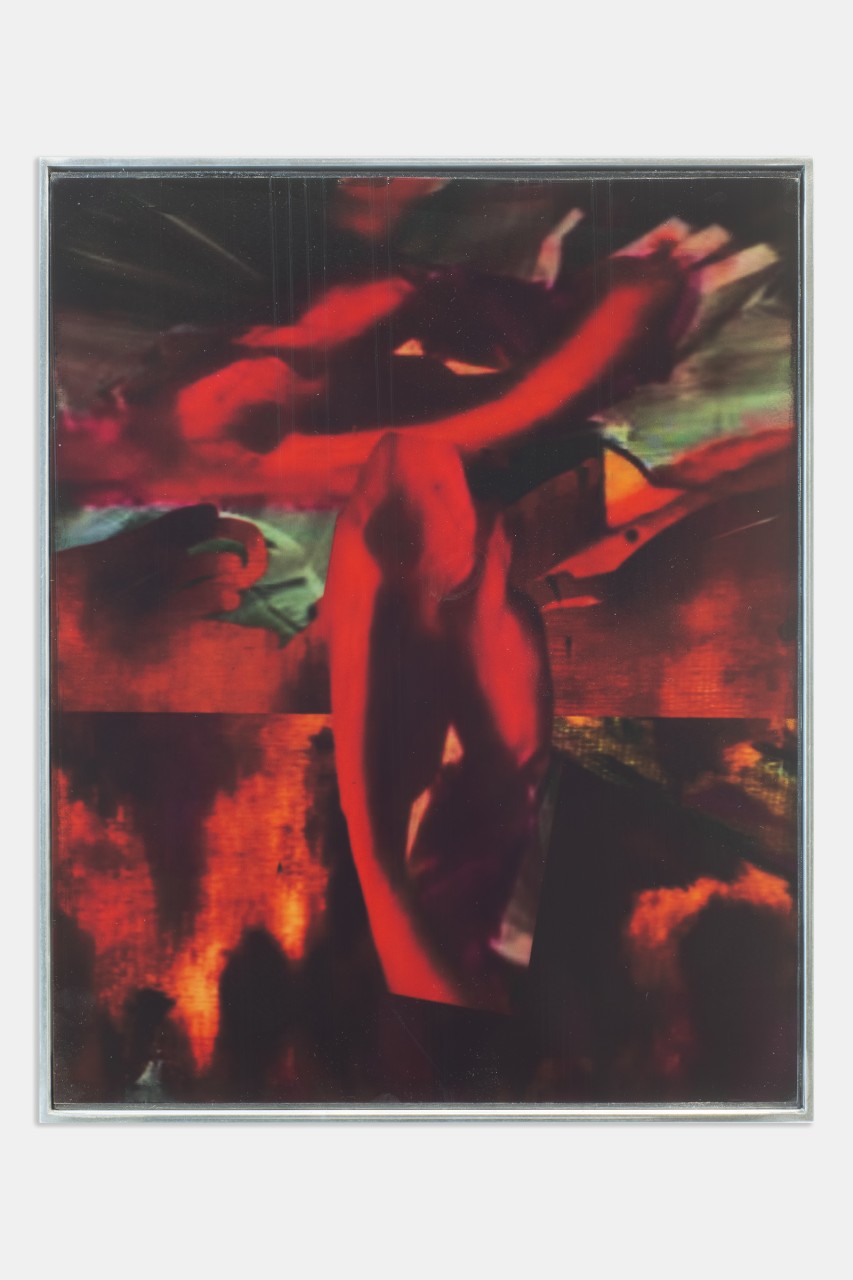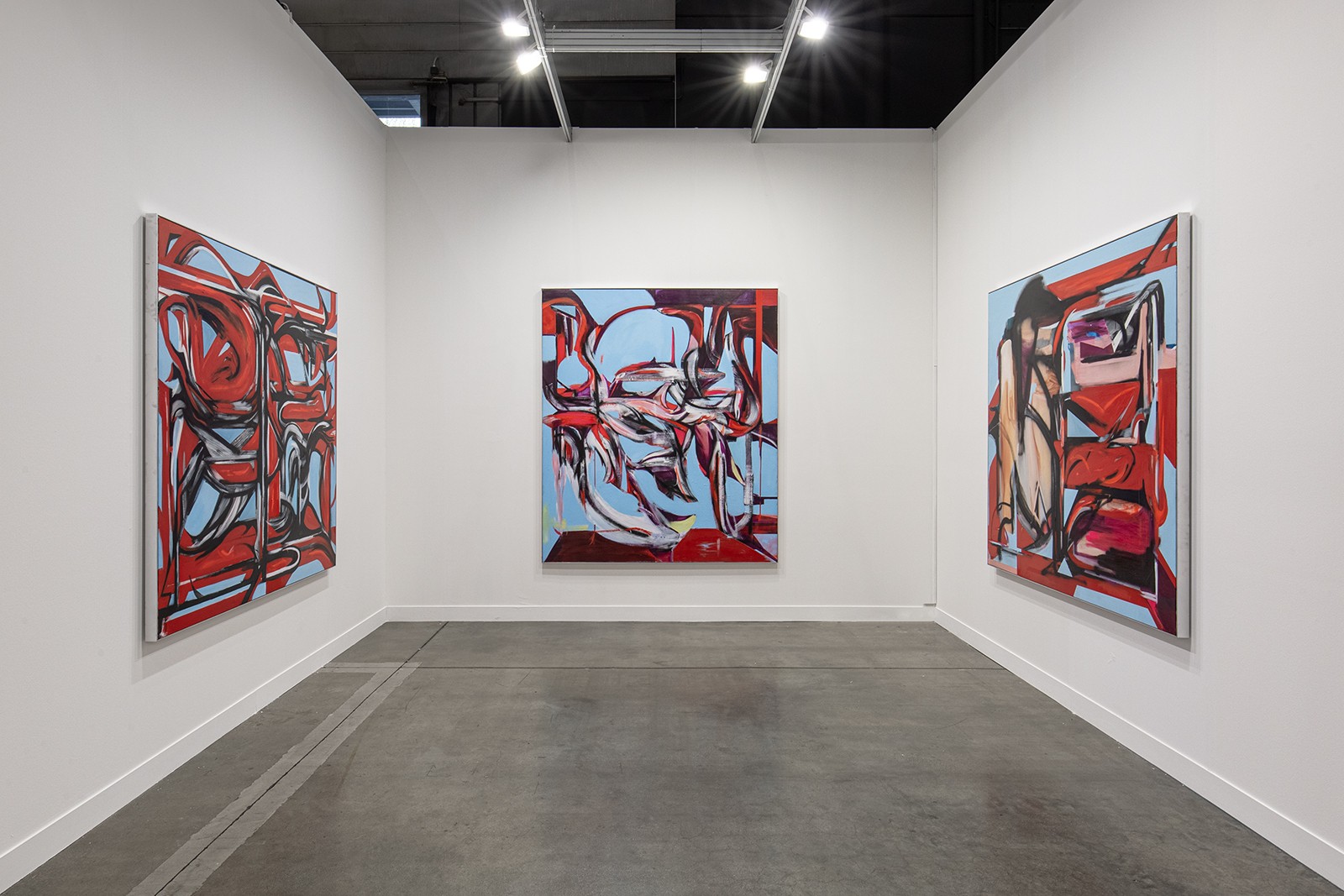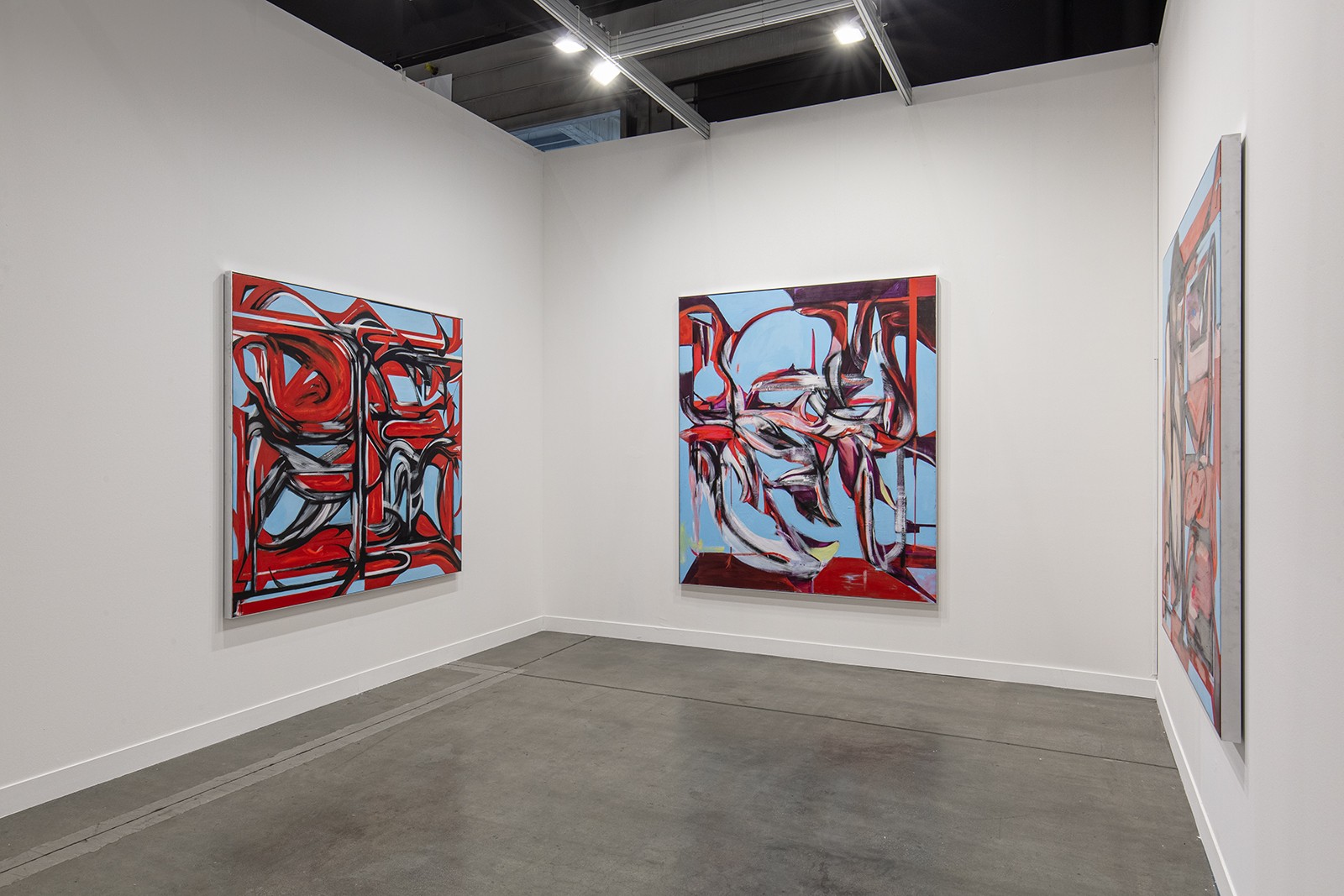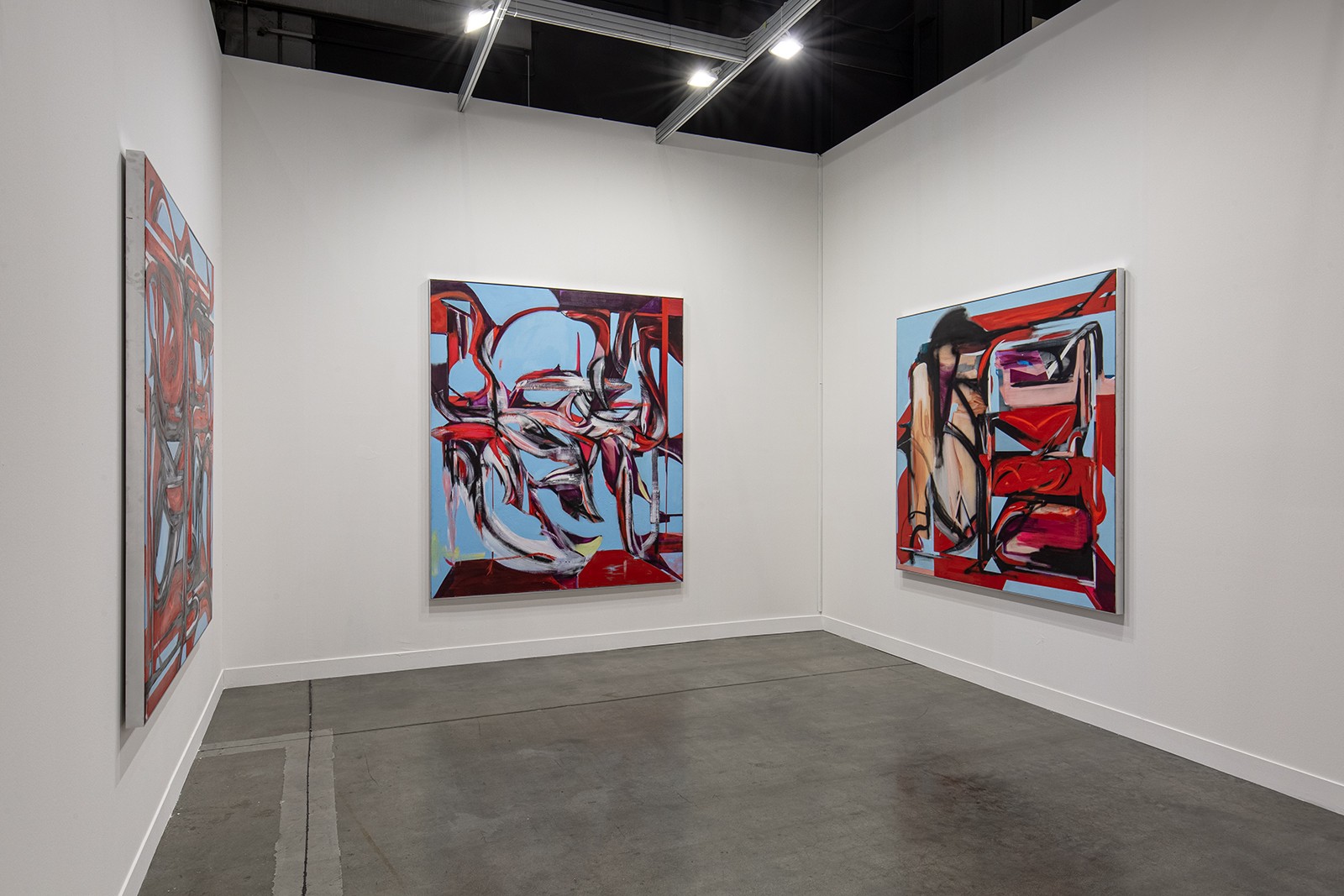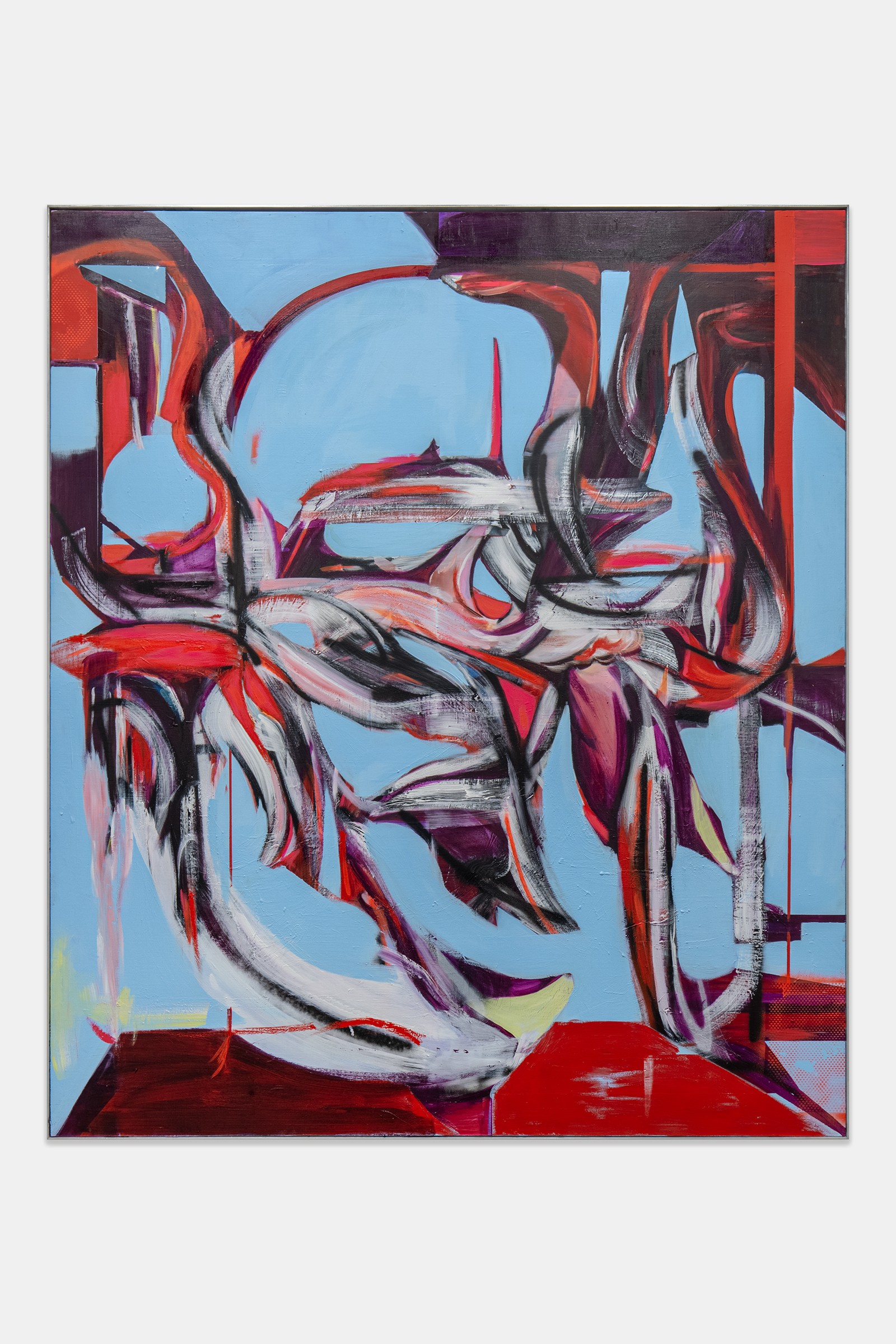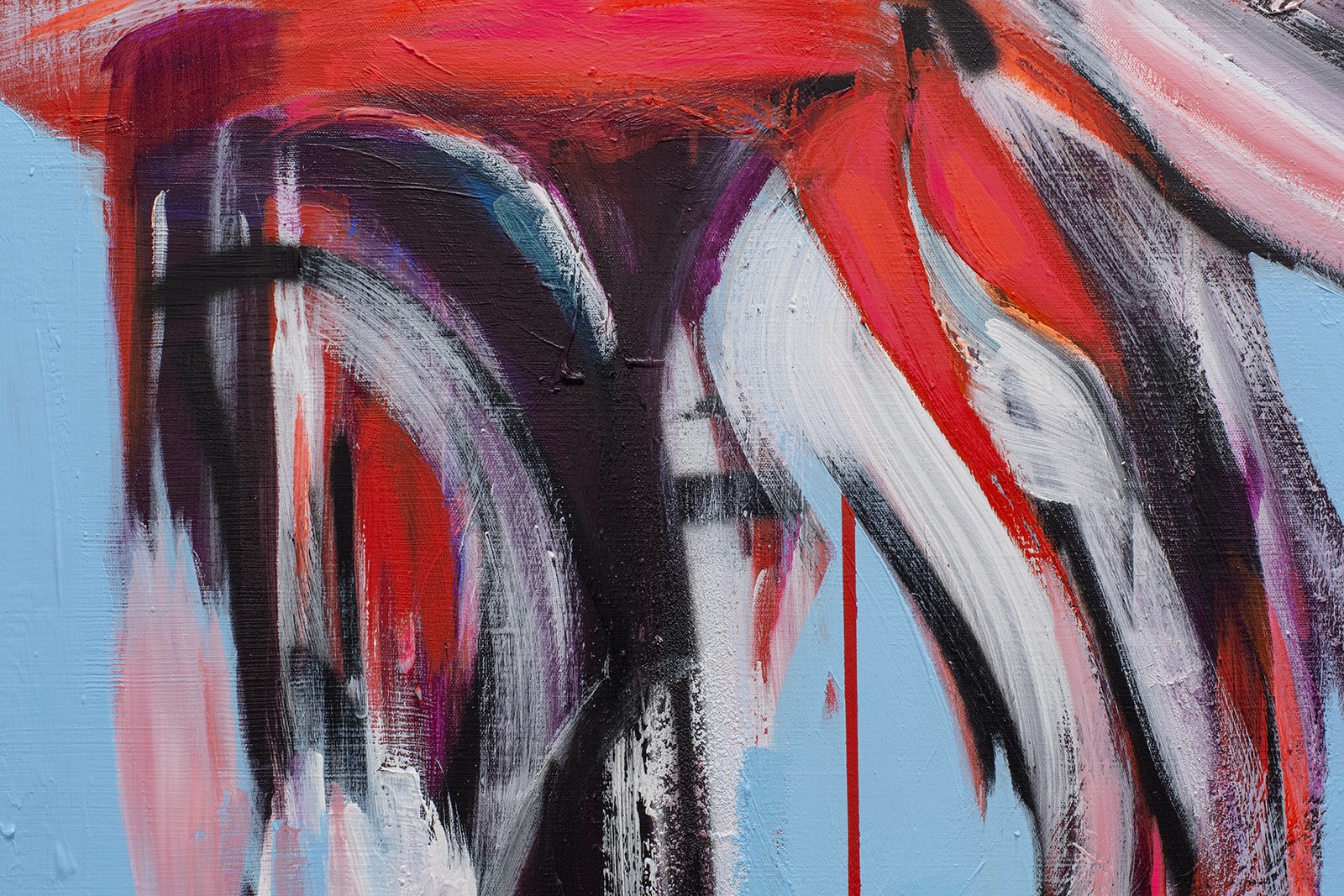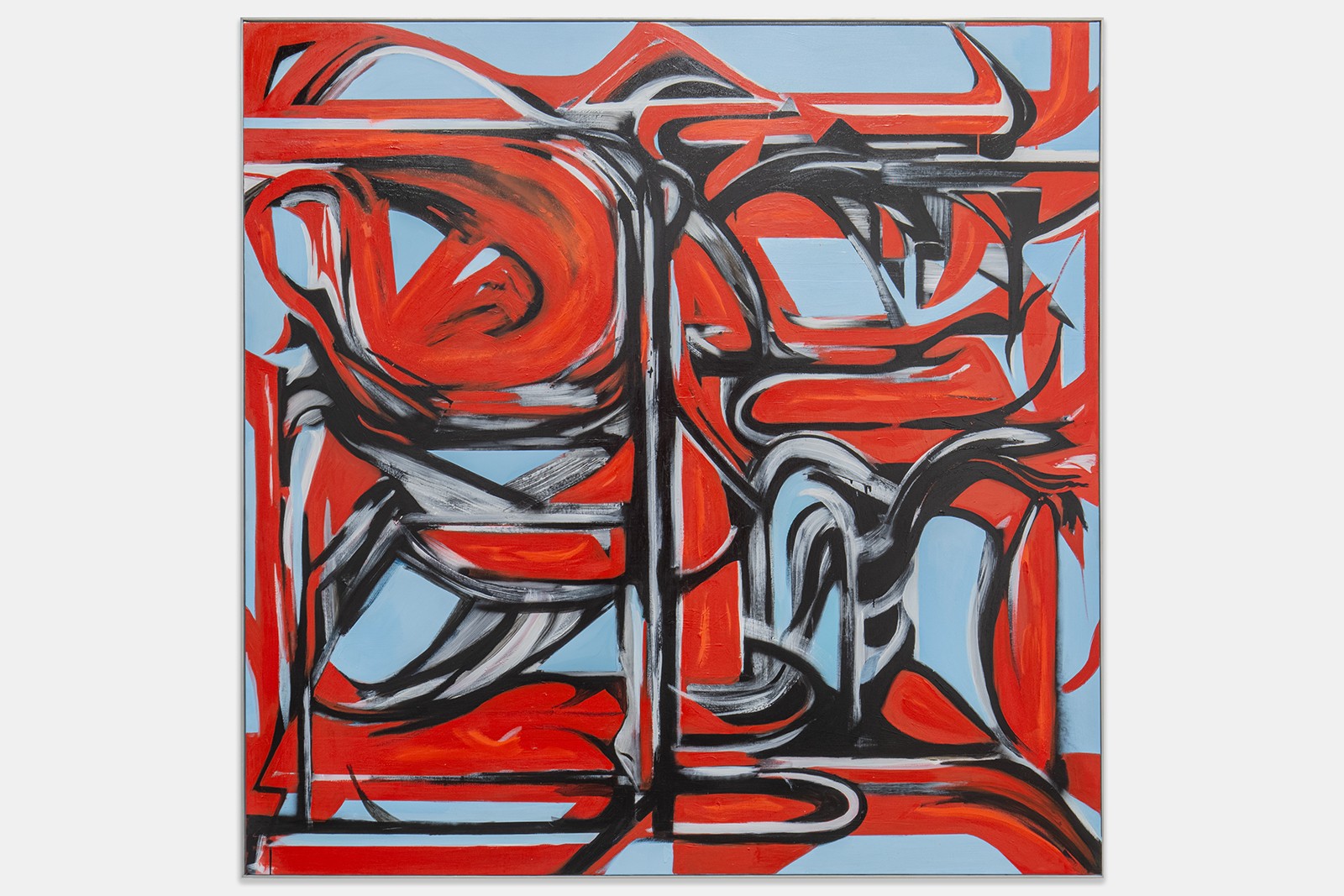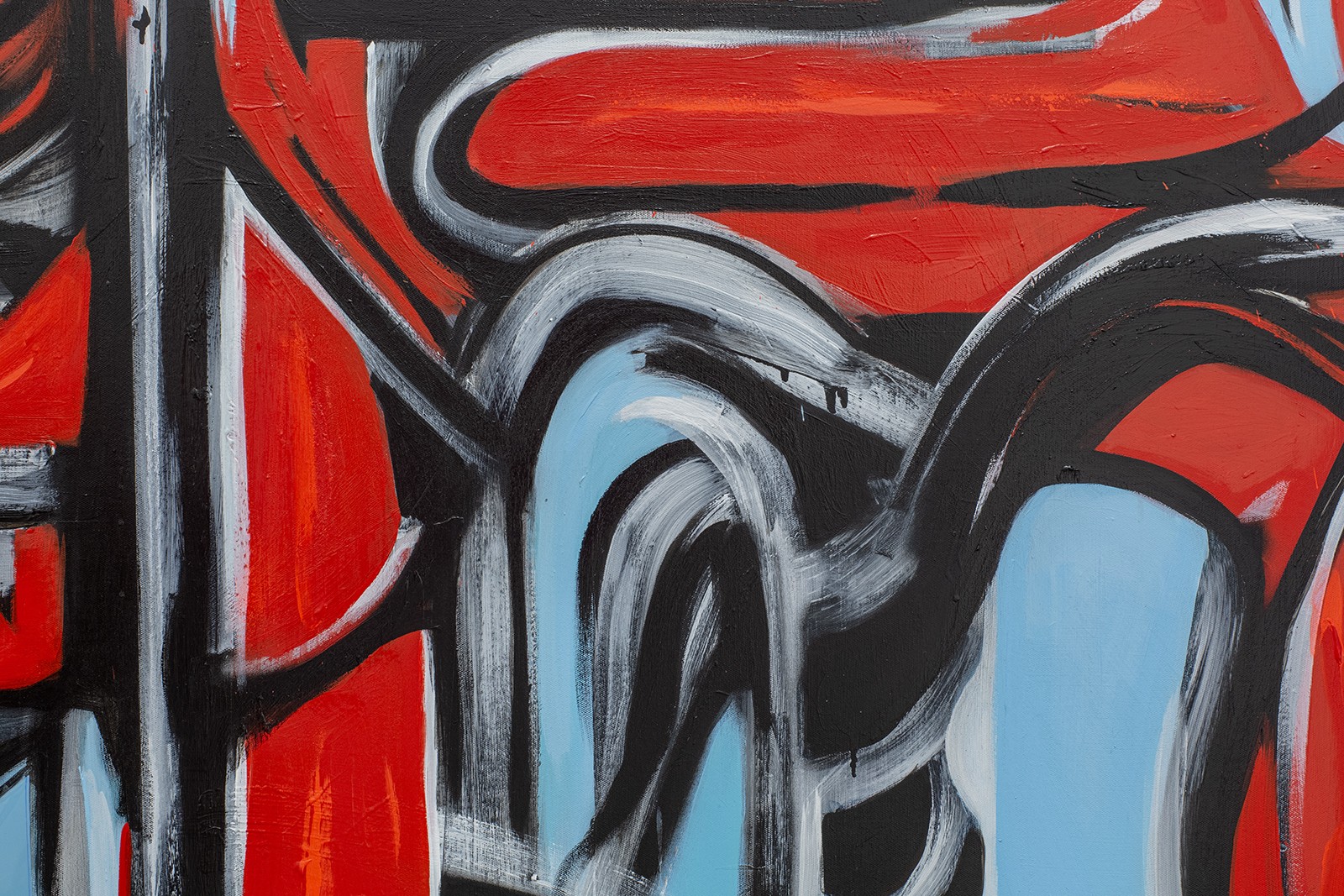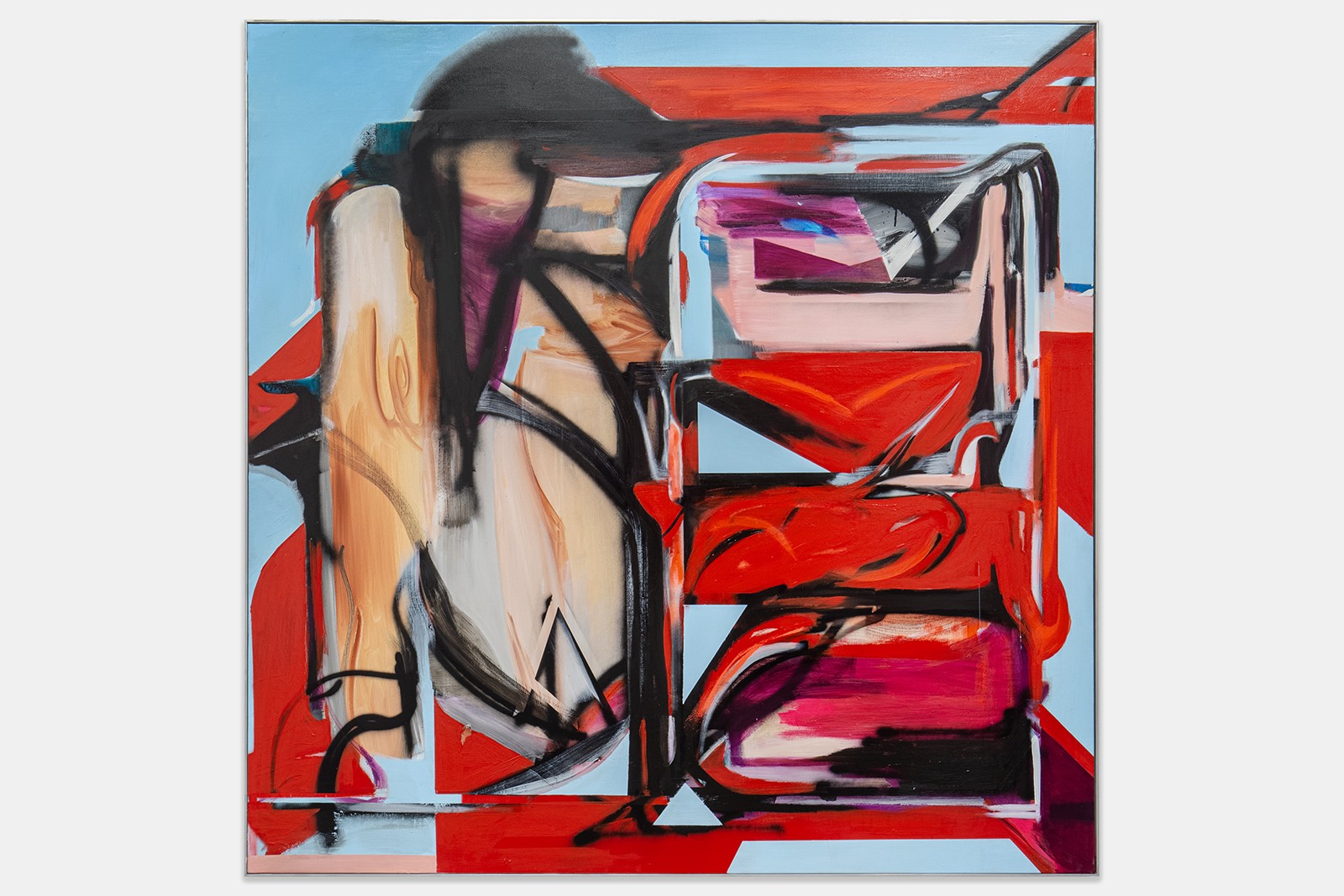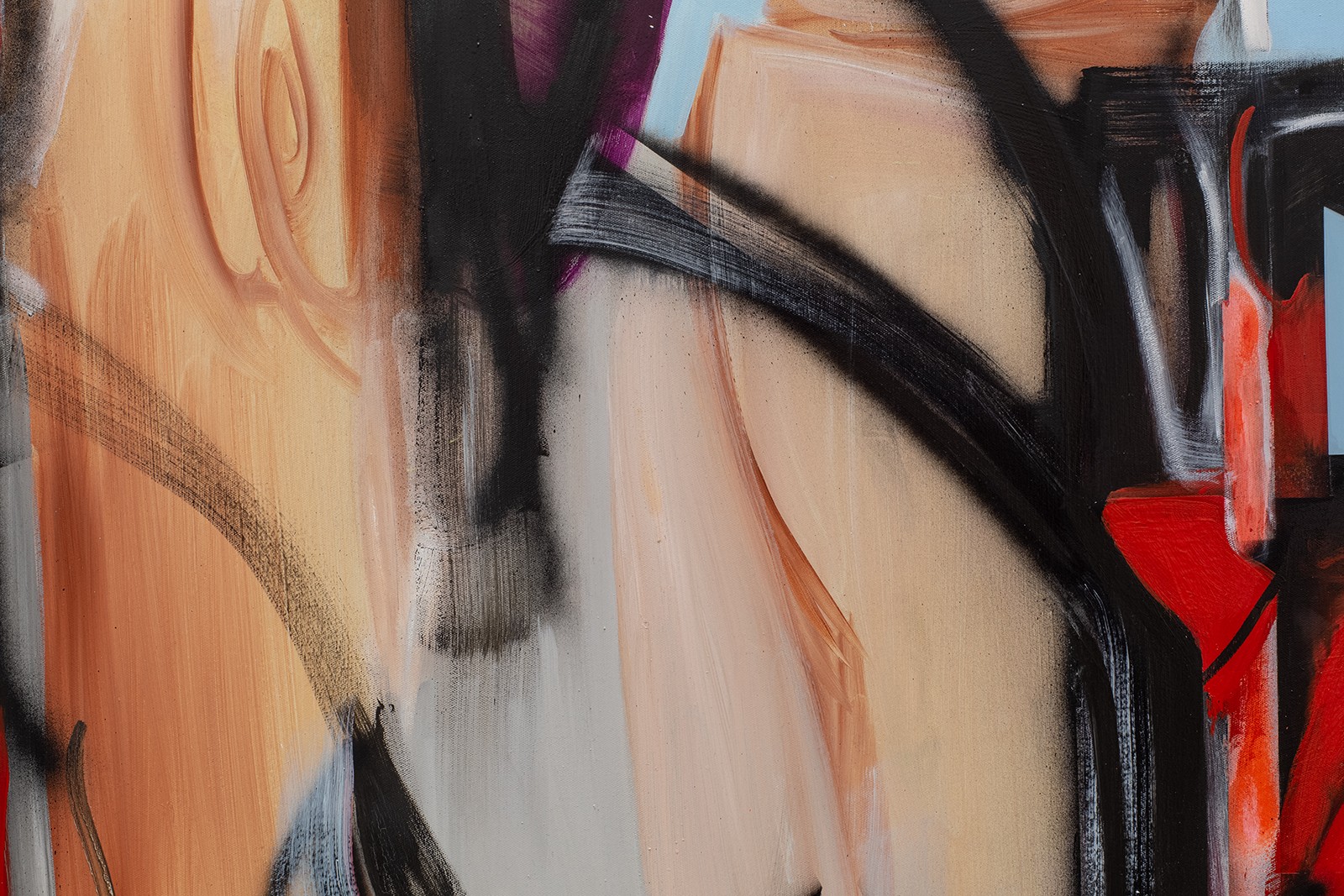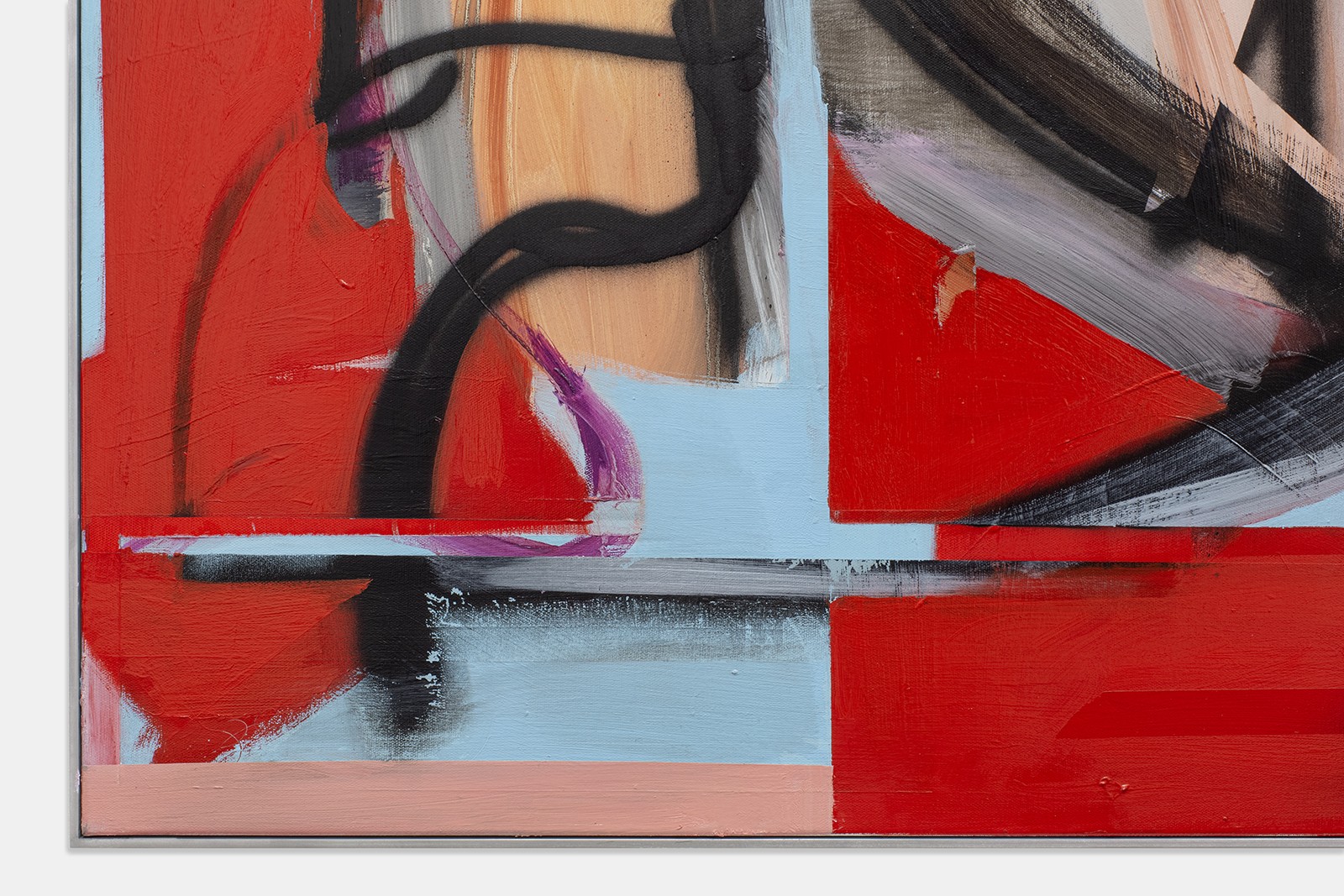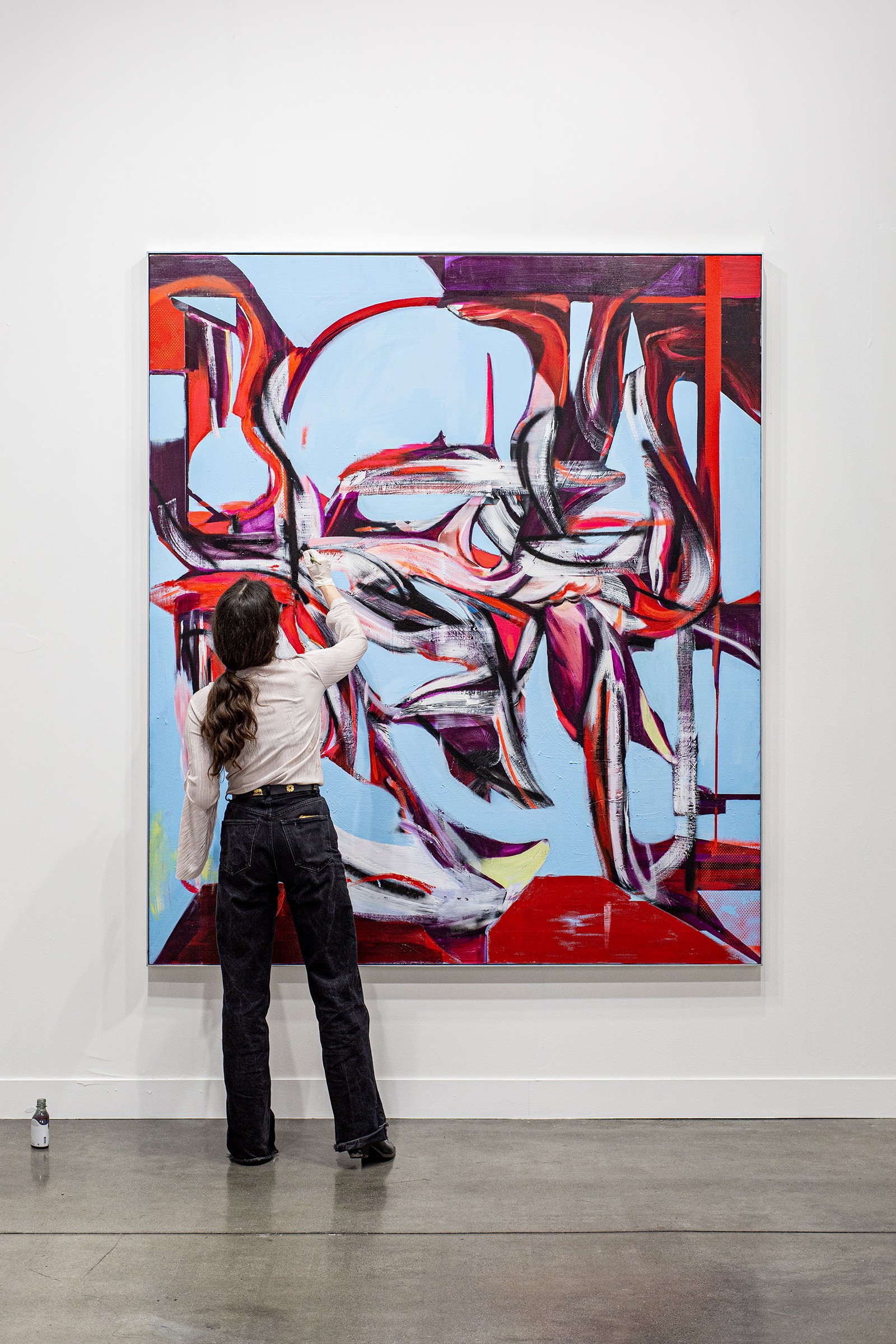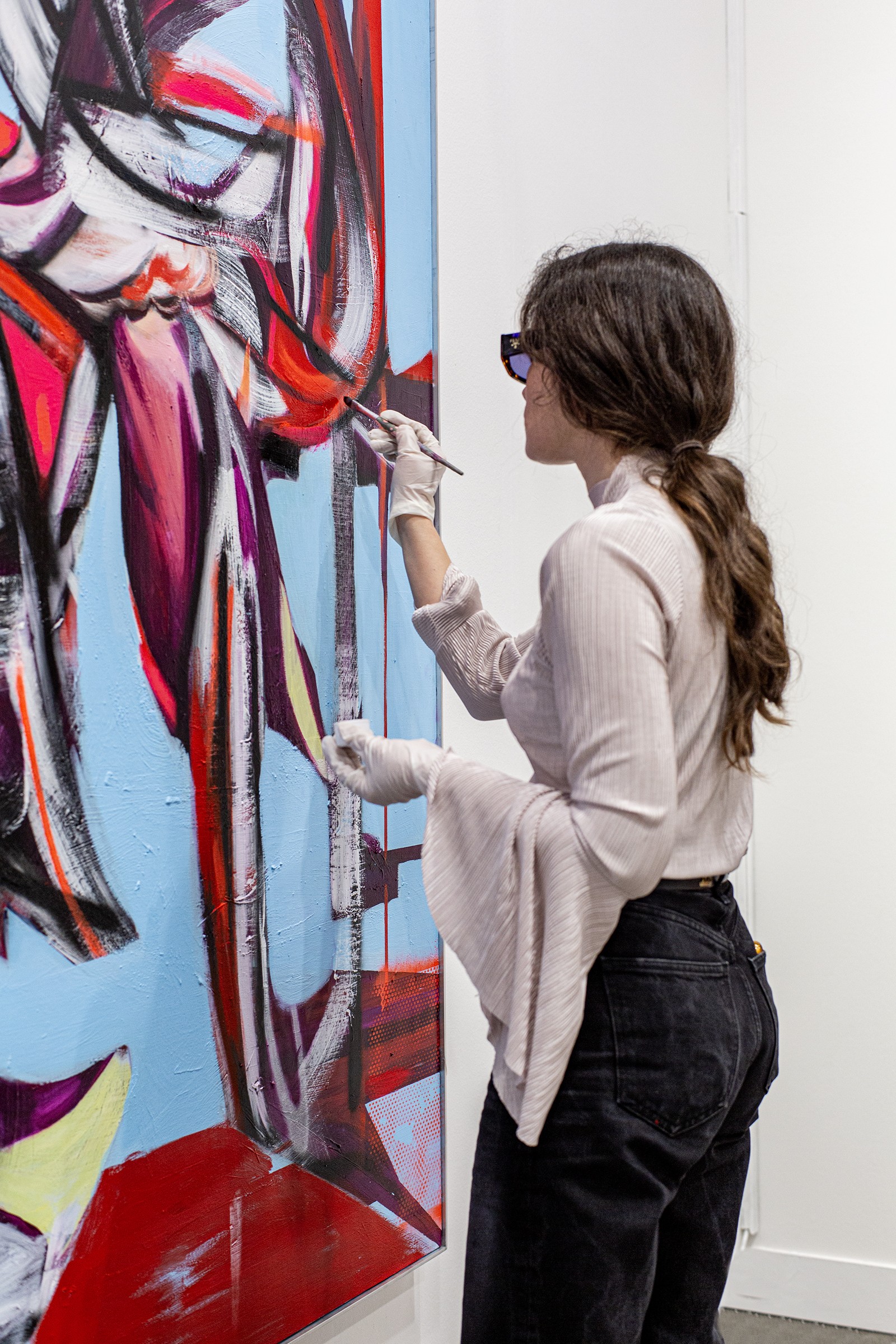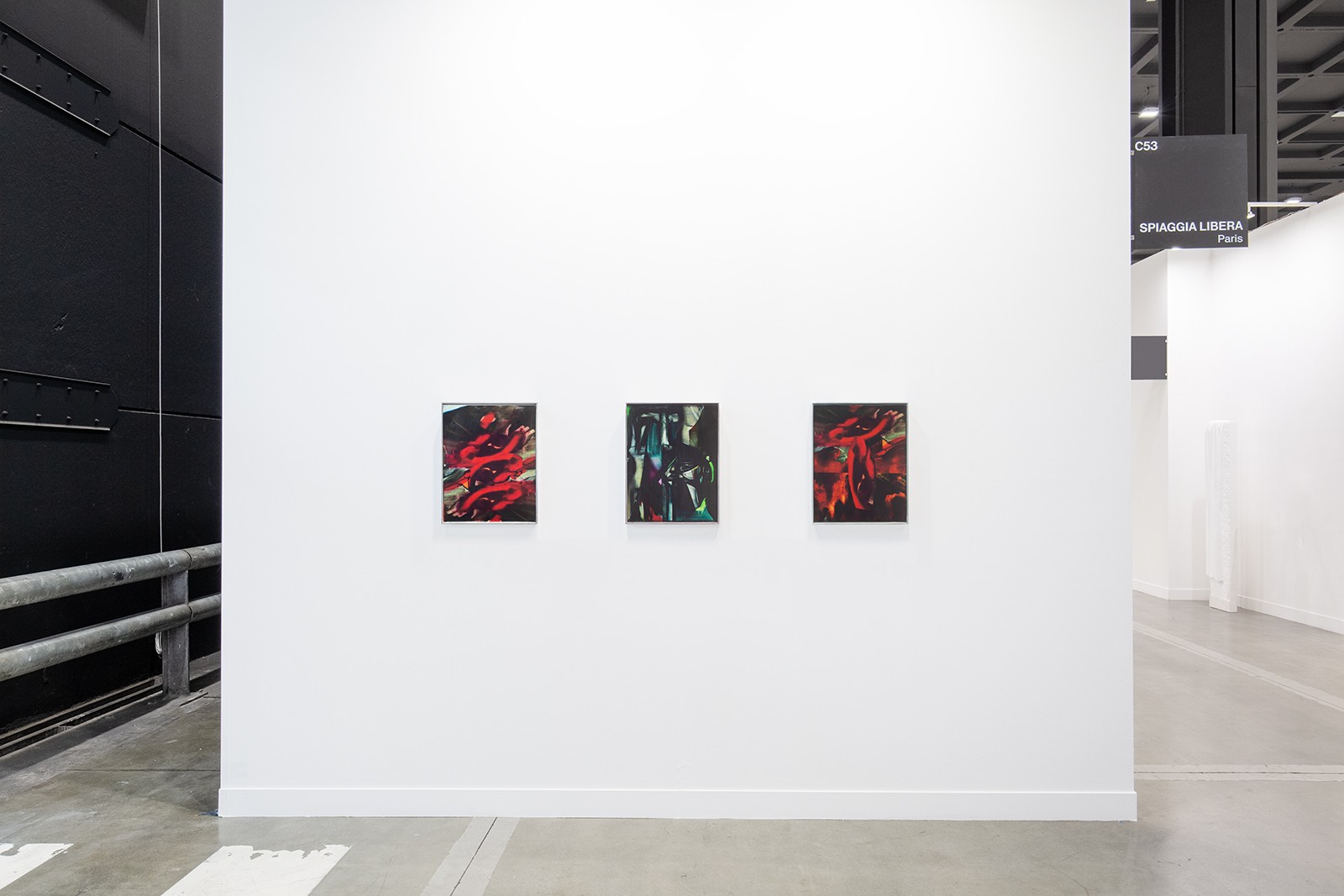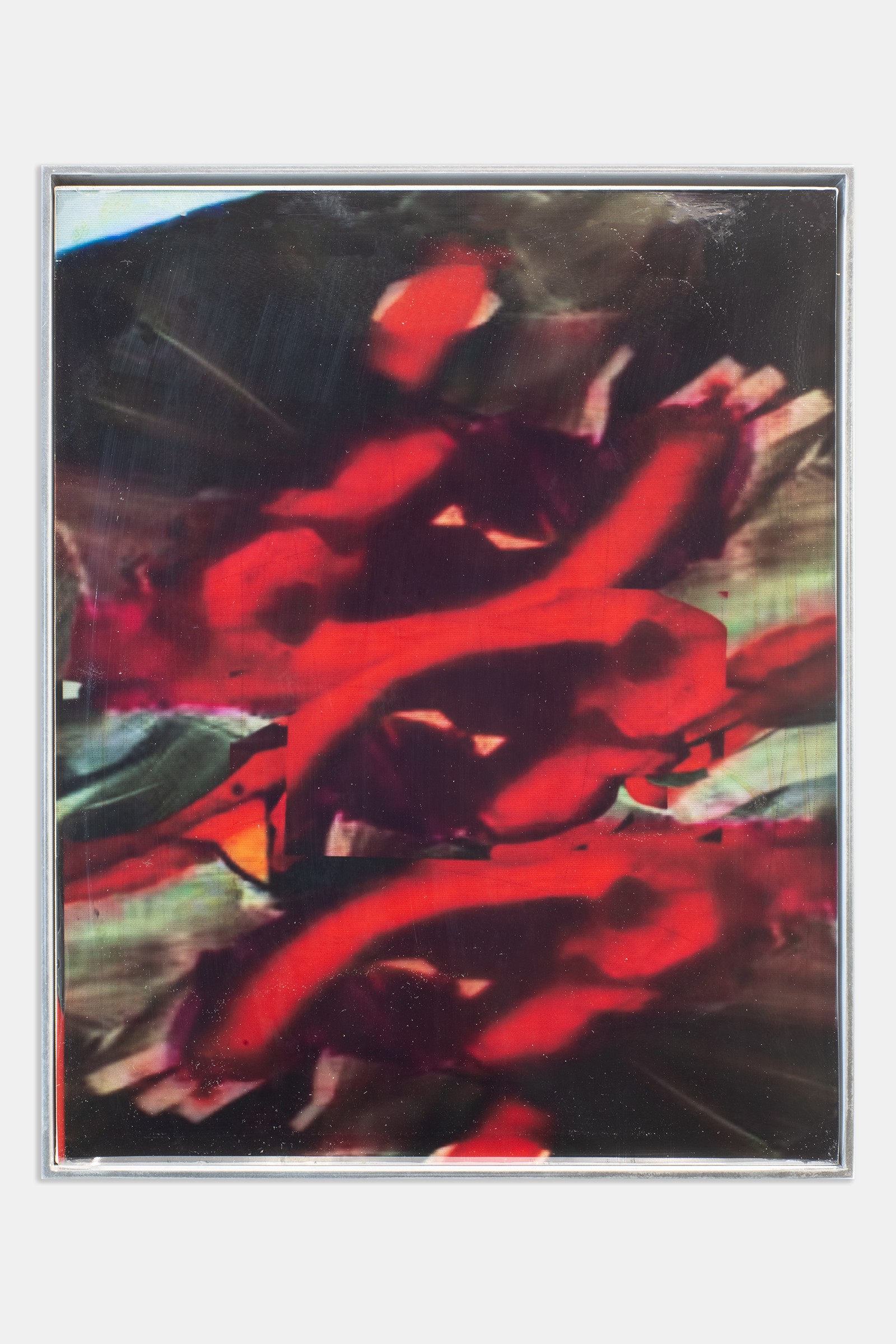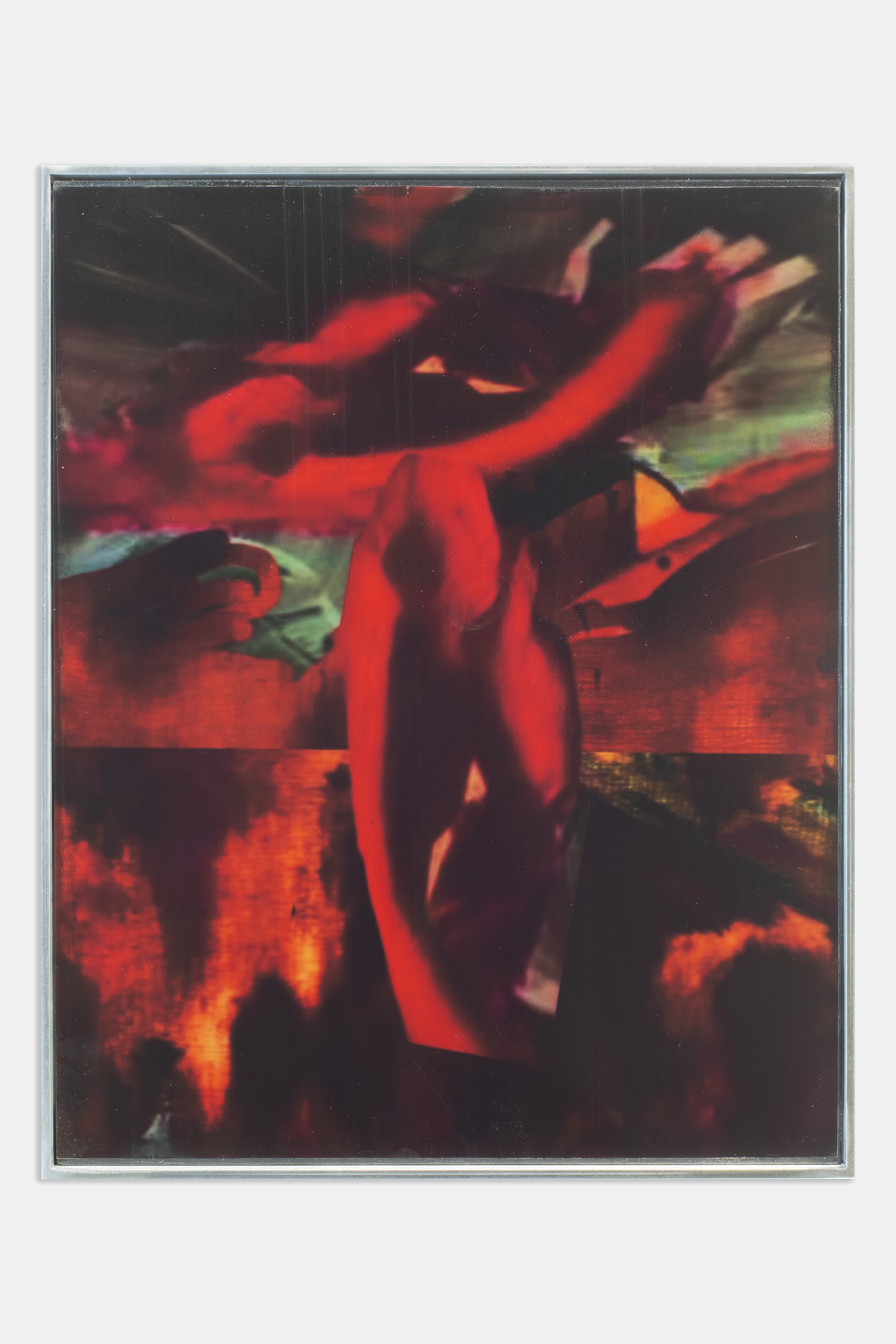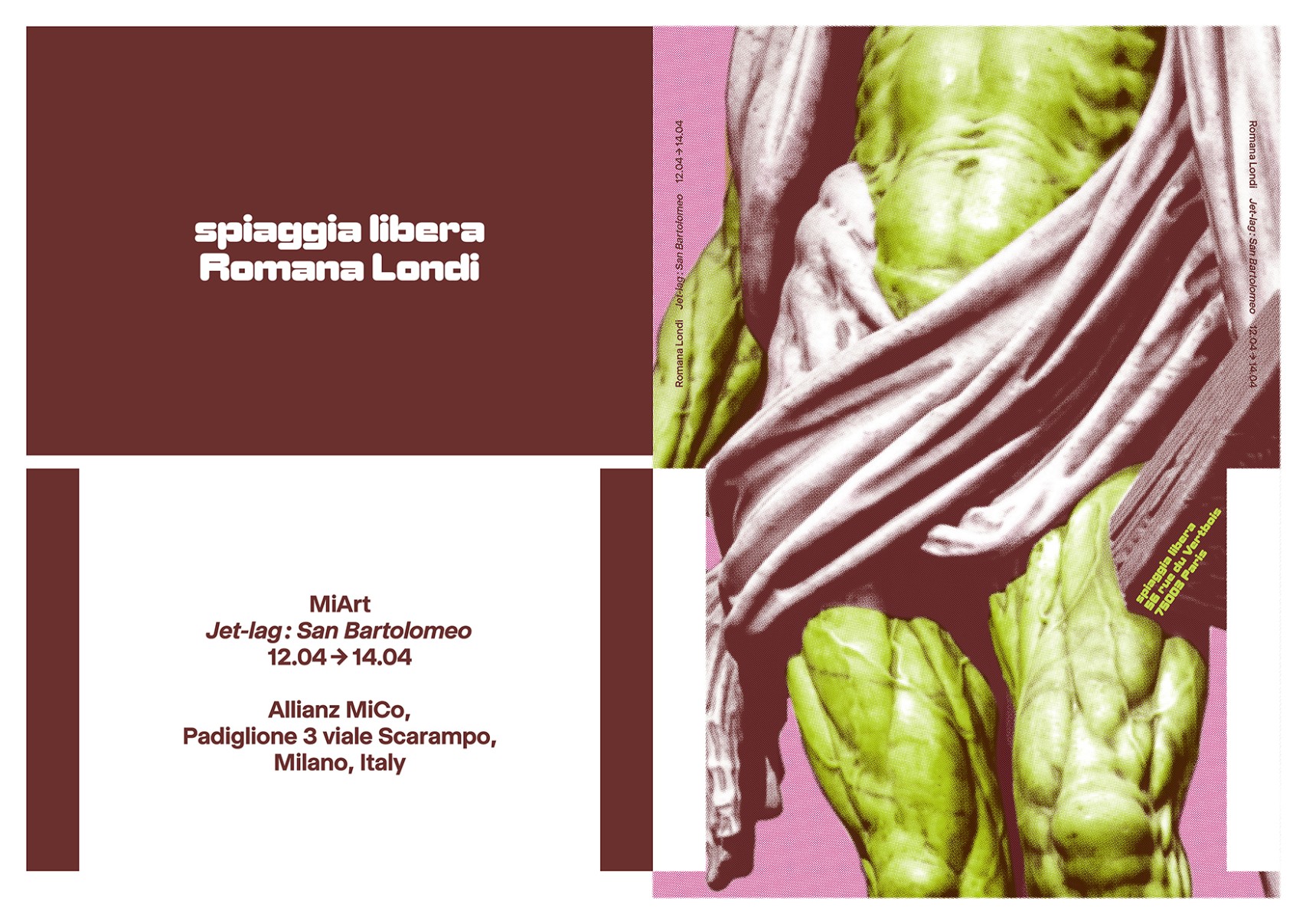
- Romana Londi
MiArt
Lullaby to the Tick of Two Clocks
In the cave which wild weeds cover…
It was once a Roman’s chamber,
Where he kept his darkest revels,
And the wild weeds twine and clamber;
It was then a chasm for devils.
Percy Bysshe Shelley, ‘A Roman’s Chamber Poem’
…
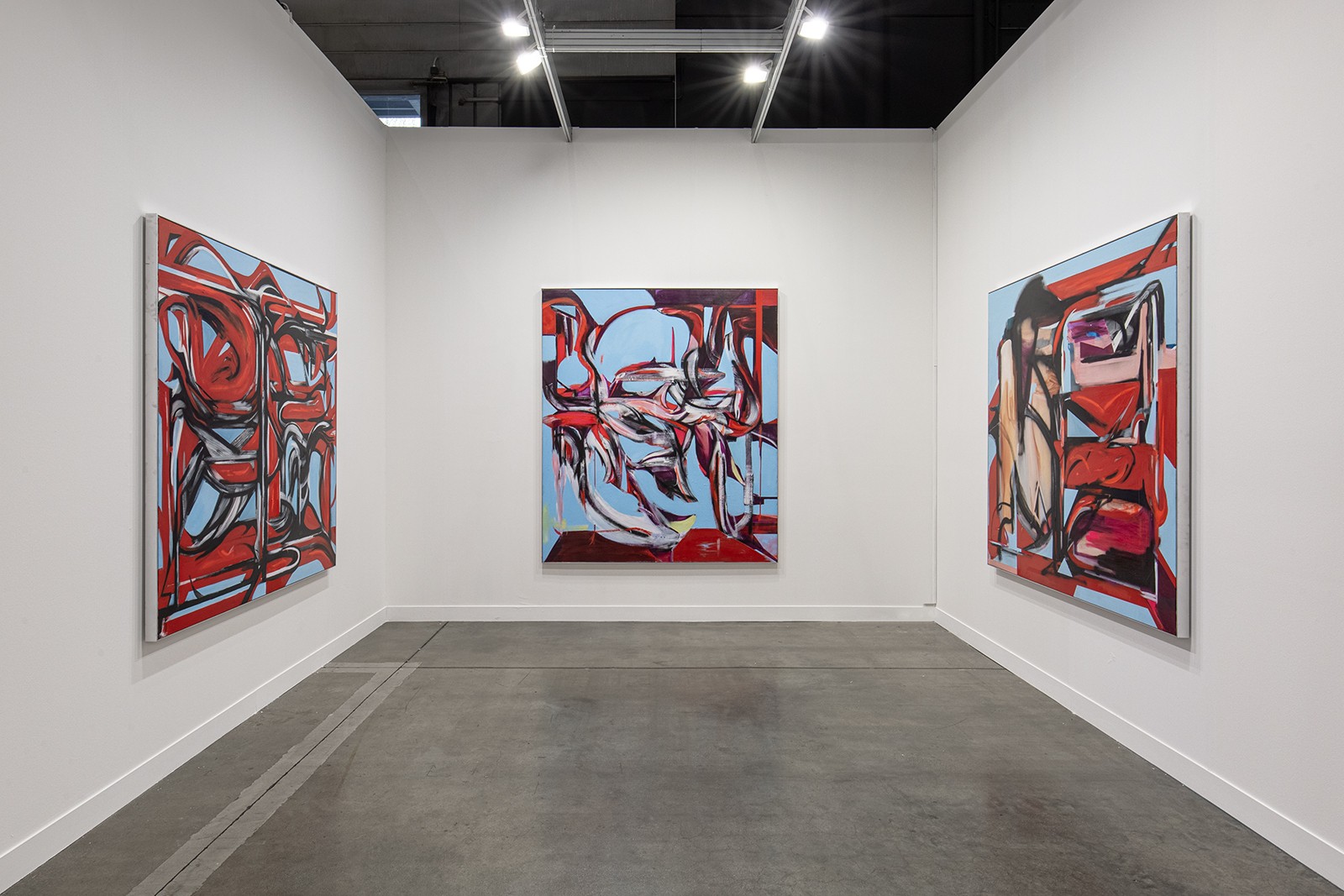
Exhibition view, Romana Londi, « Jetlag: San Bartolomeo », Miart, Milan, 2024. Photo © Gabriele Abbruzzese
Romana Londi’s work combines gestural expressiveness in thickly layered brushstrokes with an extraordinary attention to the possibilities of material experiment. The Italian-Irish artist Londi, who graduated from Central St Martins in 2009 and worked in east London for fifteen years, before recently relocating to Rome, is as much an alchemist as an artist. This is perhaps best demonstrated by her unique process of applying UV light-sensitive photochromic films to her canvases, which darkens when exposed to light and becomes clear again in shadow. In her profoundly enigmatic abstractions, Londi is a master of light and dark, developing effects of chiaroscuro for the digital age as she uses colour to find form. Whether in her Jetlag series (2019-ongoing), which titularly refers to the desynchronization of biological clocks caused by high-speed travel, or Shapeshifters (2021–ongoing), expressive matrixes of humanoid metamorphoses, or the Sentient works (2016–ongoing), which transform colours into black, Londi’s works engage with how the vulnerabilities of the human form become transformed against itself in a world that has become increasingly uninhabitable, and increasingly hostile to nature. Londi’s works delve into important ontological questions on the nature of physiological transformation in an uncertain world, and ask us: How do our bodies and our minds change and yet some irrepressible sense of ourselves remains the same? How can painting today reach back into the history of art and recuperate solace for our disembodied age of AI, morbid screen addictions, and the closed loop of the metaverse? How will we feel about our sensual abilities at a time when technological advances may yet render them functionally obsolete?
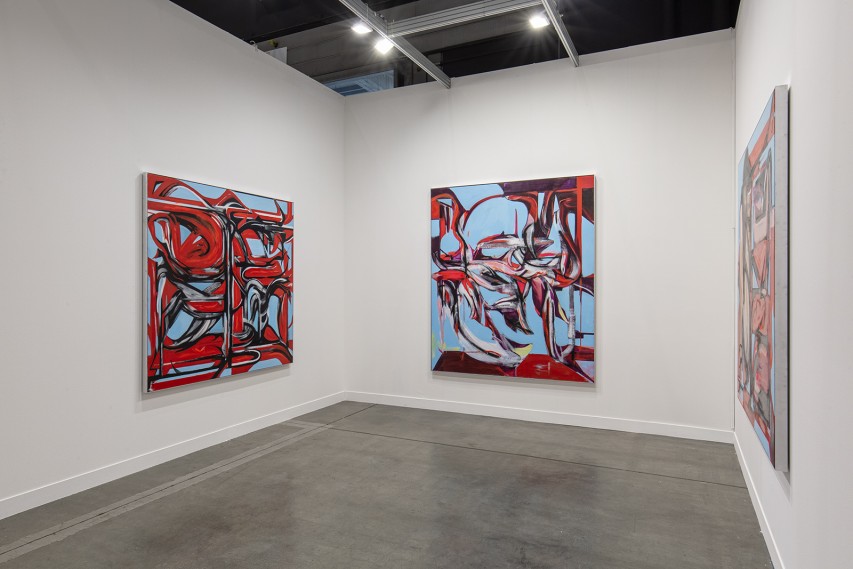
Exhibition view, Romana Londi, « Jetlag: San Bartolomeo », Miart, Milan, 2024. Photo © Gabriele Abbruzzese
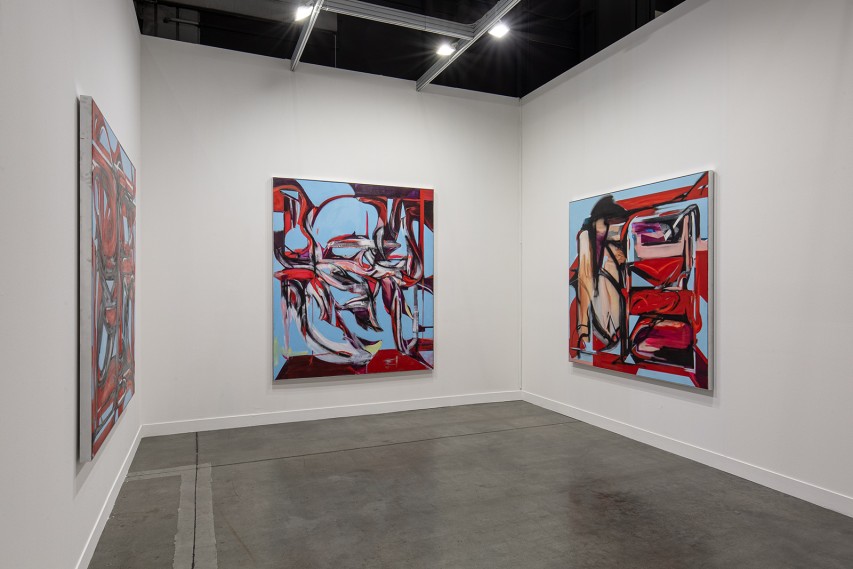
Exhibition view, Romana Londi, « Jetlag: San Bartolomeo », Miart, Milan, 2024. Photo © Gabriele Abbruzzese
Having been born and brought up in central Rome, Londi returned to her native city to reconnect with its extraordinary cultural influence, and to balance the weight of its art historical precedents with a creative lightness to make new works that recuperate eternal themes. The Eternal City also provides nearly unlimited access to medieval and Renaissance masterpieces, in churches, convents, and museums, and devotional paintings with their iconographical symbolism (if not the belief structures they express) have inspired new directions for her work. Bernard van Orley’s The Seven Joys of the Virgin (undated), on display at the Galleria Colonna, depicts the Madonna with the infant Christ on her knee, as seven moments from her life, from the Annunciation to the Nativity, appear in disc-shaped time capsules like spinning halos above her dead. Noting how these moments in time are depicted through a Neoplatonic circle, but wanting to narrate human finitude rather than divine revelation, Londi turned to an even older example of the symbolic shape: the triangle in the cave. In this case, the triangle, which has no correlative in the natural world, paleolithic anthropologists believed that the shape was scrawled onto cavernous entrances to warn subsequent travellers that the head and shoulders of the body are too large to pass through. Alongside a forewarning of danger, or a sense of directions, in their earliest usage triangles stand for a kind of human limit. Londi has included triangular shapes in several of her works, which are made not with paint but with photochromatic film. As such, these triangles change colour and therefore the temperature of the works’ meaning. The ultimate or absolute truth of the work is a fugitive in an endless temporal experiment. In Londi’s universe of forms, it matters who you are and where you are standing; hers is a living situation of art.
Who Real ⸮, 2024, oil paint and acrylic on canvas, photochromic film, 220 x 190 cm. Courtesy the artist & Spiaggia Libera, Paris. Photo © Gabriele Abbruzzese
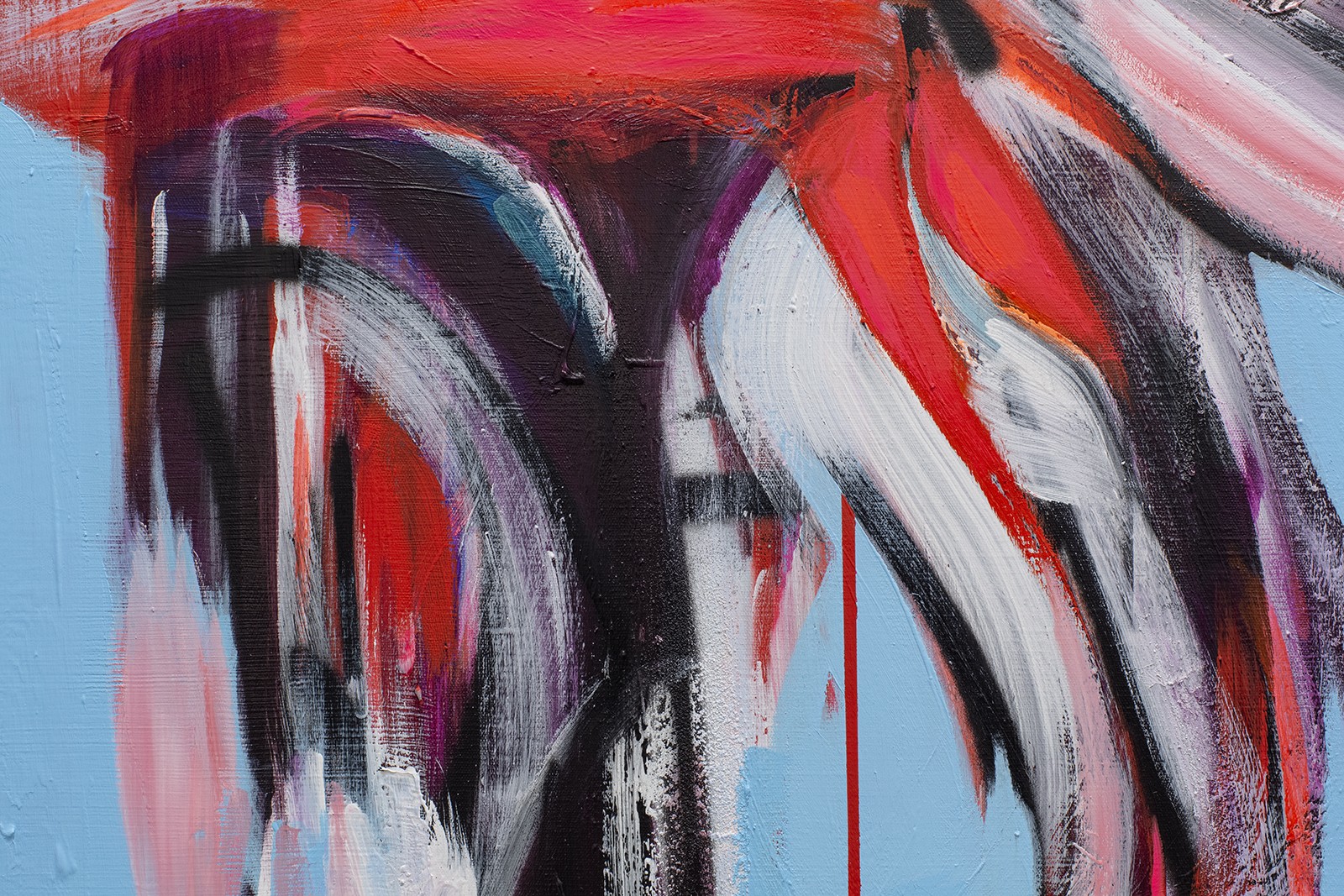
Who Real ⸮ (close up), 2024, oil paint and acrylic on canvas, photochromic film, 220 x 190 cm. Courtesy the artist & Spiaggia Libera, Paris. Photo © Gabriele Abbruzzese
In Thoughts (2023-24), made using an extraordinary array of materials (oil, acrylic, spray paint, solid oil, and photochromic film painted on a linen canvas and aluminium frame), Londi abstractly depicts such an encounter in which life cannot pass any further into the world. The luscious strokes of paint curve and coalesce but are almost immediately contained in a larger structure that reorders movement but refuses to explain its total logic. As such, the painting itself resembles a network or system; look at the way the cylindrical black forms, both linear and non-linear, seem to pump their power through the valves and closed circuits of the red industrial-like structure. Here, Londi has achieved something rare so late in the history of abstract painting: to be both gestural and architectonic simultaneously, and to contain something of both the human anatomy and the totalizing post-industrial environment, where all life is subsumed into capital, that constrains it. Londi manages to give life and take it away in the same picture.
Apple Riped, 2024, oil paint and acrylic on canvas, photochromic film, 180 x 180 cm. Courtesy the artist & Spiaggia Libera, Paris. Photo © Gabriele Abbruzzese
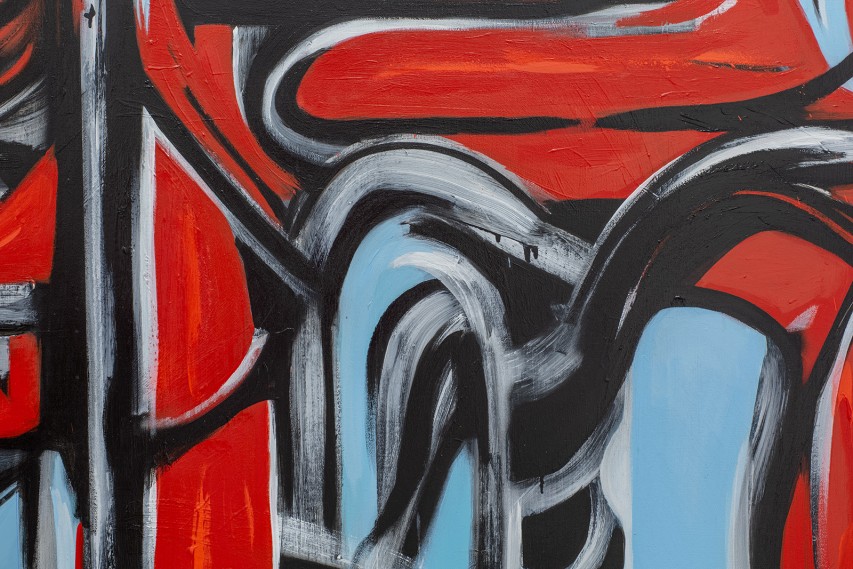
Apple Riped (close up), 2024, oil paint and acrylic on canvas, photochromic film, 180 x 180 cm. Courtesy the artist & Spiaggia Libera, Paris. Photo © Gabriel Abbruzzese
In her recent investigations scouring Roman churches, Londi was struck by the prevalence of representations of Saint Bartholomew, and basked in reproductions of Matteo di Giovanni’s version at the Museum of Fine Arts in Budapest. Bartholomew is depicted as being skinned alive with the saint then pictured holding his flayed skin and the knife which mutilated him, somehow still, or still partly, alive. Several paintings by Londi reference this poor saint, most explicitly The Skinning of San Bartolomeo (2023-24). We see something of an outstretched leg, something of the displayed hand, something of the pious but weary face. The black-and-white grave of the body, indexed by juts of lines like an anatomical figure at play, is wincingly bare against the pink and red coat of flesh that flows like a torrent in an arena of scarlet. At the foot of the painting, triangles of blue signal the flourish of an escape beyond; including these triangular forms offer some solace, while emphasising the saint’s physiological entrapment in the foreground. ‘I became enamoured with the enigmatic figure of Saint Bartholomew’, Londi has said, ‘because he was a man who has learned to live without his body.’ But, more than this, Londi recognizes how by ‘reclaiming his own skin and wearing it as a dress, he reclaims a certain sensibility out of his vulnerability.’
Hewn from Darkness, Forged from Light, 2024, oil paint and acrylic on canvas, photochromic film, 180 x 180 cm. Courtesy the artist & Spiaggia Libera, Paris. Photo © Gabriele Abbruzzese
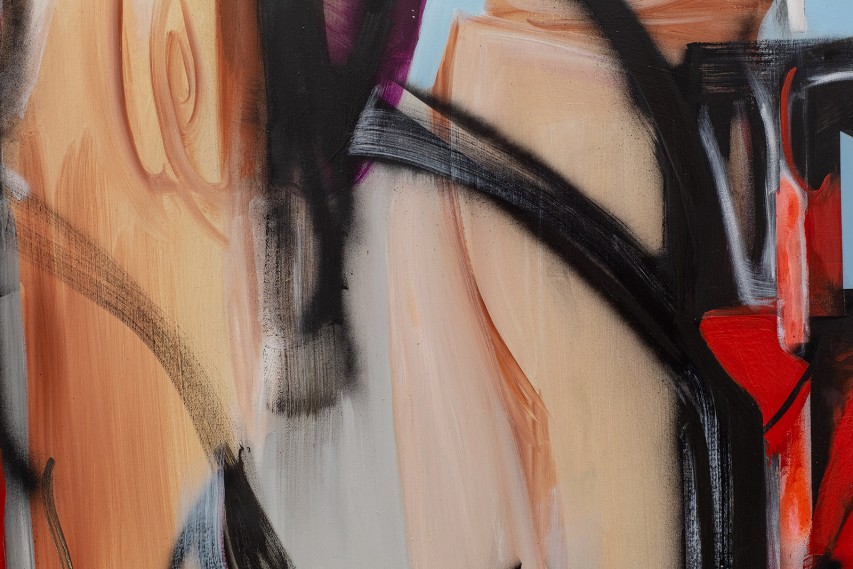
Hewn from Darkness, Forged from Light (close up), 2024, oil paint and acrylic on canvas, photochromic film, 180 x 180 cm. Courtesy the artist & Spiaggia Libera, Paris. Photo © Gabriele Abbruzzese
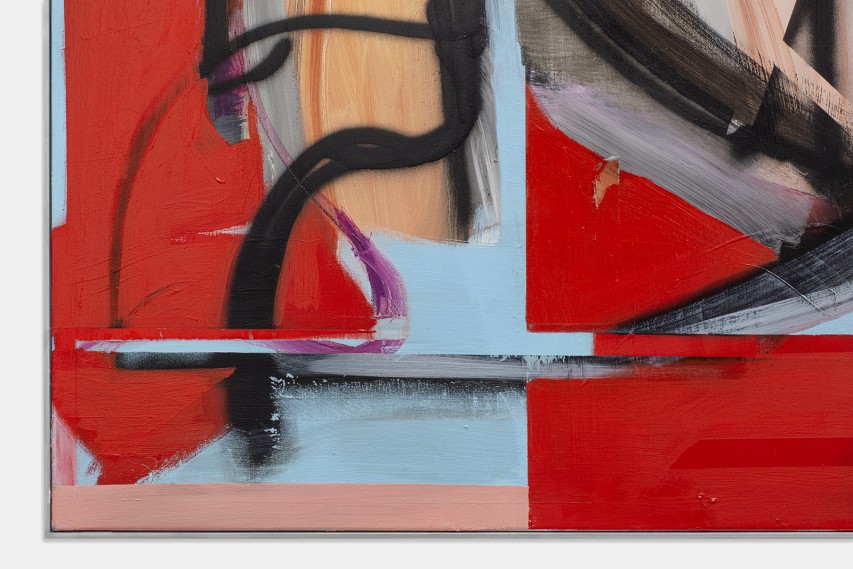
Hewn from Darkness, Forged from Light (close up), 2024, oil paint and acrylic on canvas, photochromic film, 180 x 180 cm. Courtesy the artist & Spiaggia Libera, Paris. Photo © Gabriele Abbruzzese
It is difficult to underestimate the expressive power of Londi’s Shapeshifter paintings, such as There Be Dragons, and The Devil’s Tale (both 2023-24) especially given how remarkable their spatial organization appears to lunge to the surface, out at you like falling scaffolding, as well as pared back, stripped, held down against the pallid pink backdrop, like a bound prisoner. Small triangular arrows imply some sense of exit from the malaise; their course surely leads nowhere. Near Saint-Paul-de-Vence in Provence, there is a sculpture display of works by Alberto Giacometti: what strikes you most is the ways in which they are concurrently both visceral and abstract. A Giacometti figure discloses both an imperceptible sense of our humanness and yet also a brute, sensual conceptualization of how we exist as humans. Also skeletal, and elongated to stretch the very limits of human embodiment, Londi’s shapeshifters achieve the same effect: to confront us with our radical vulnerability and fallibility in a world where technological developments are making everything else sentient, except for us.
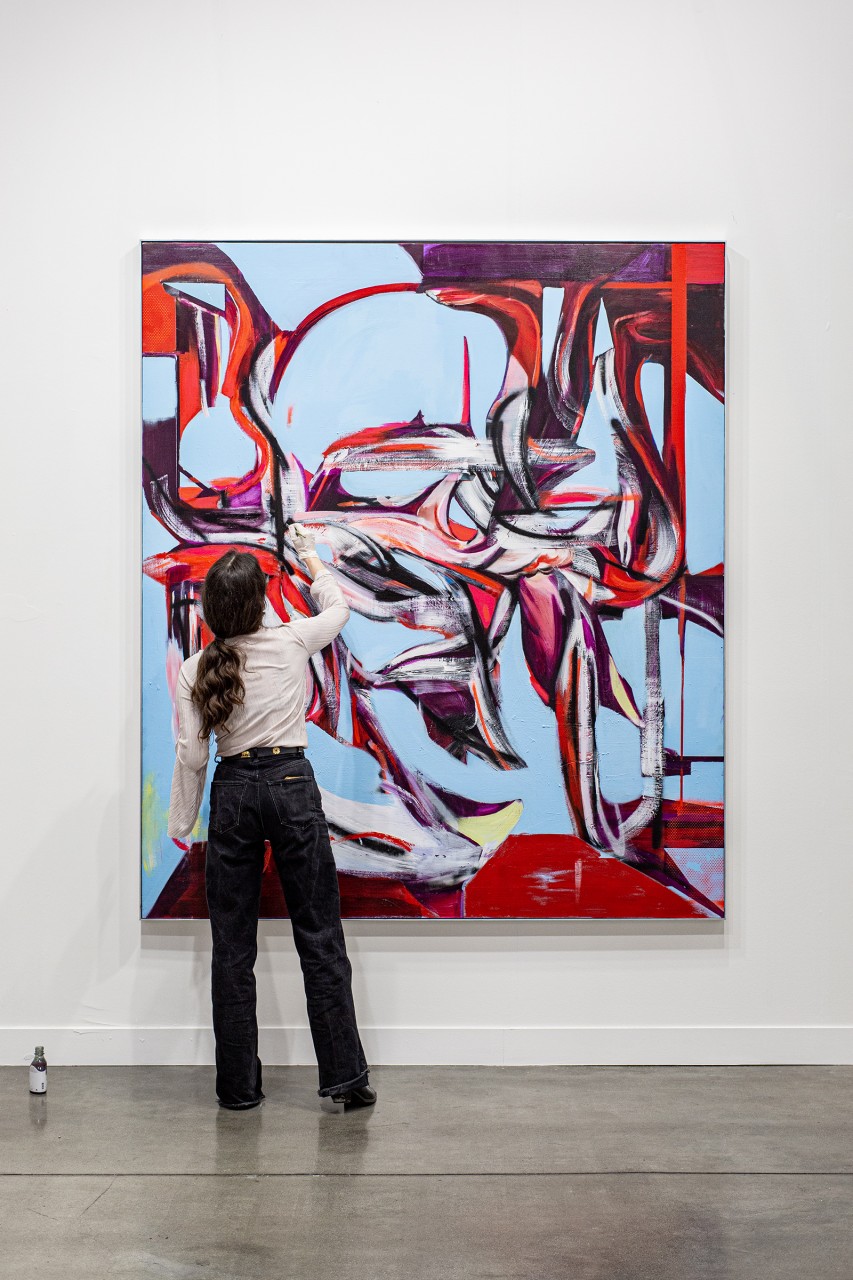
Exhibition view, Romana Londi, « Jetlag: San Bartolomeo », Miart, Milan, 2024. Photo © Gabriele Abbruzzese
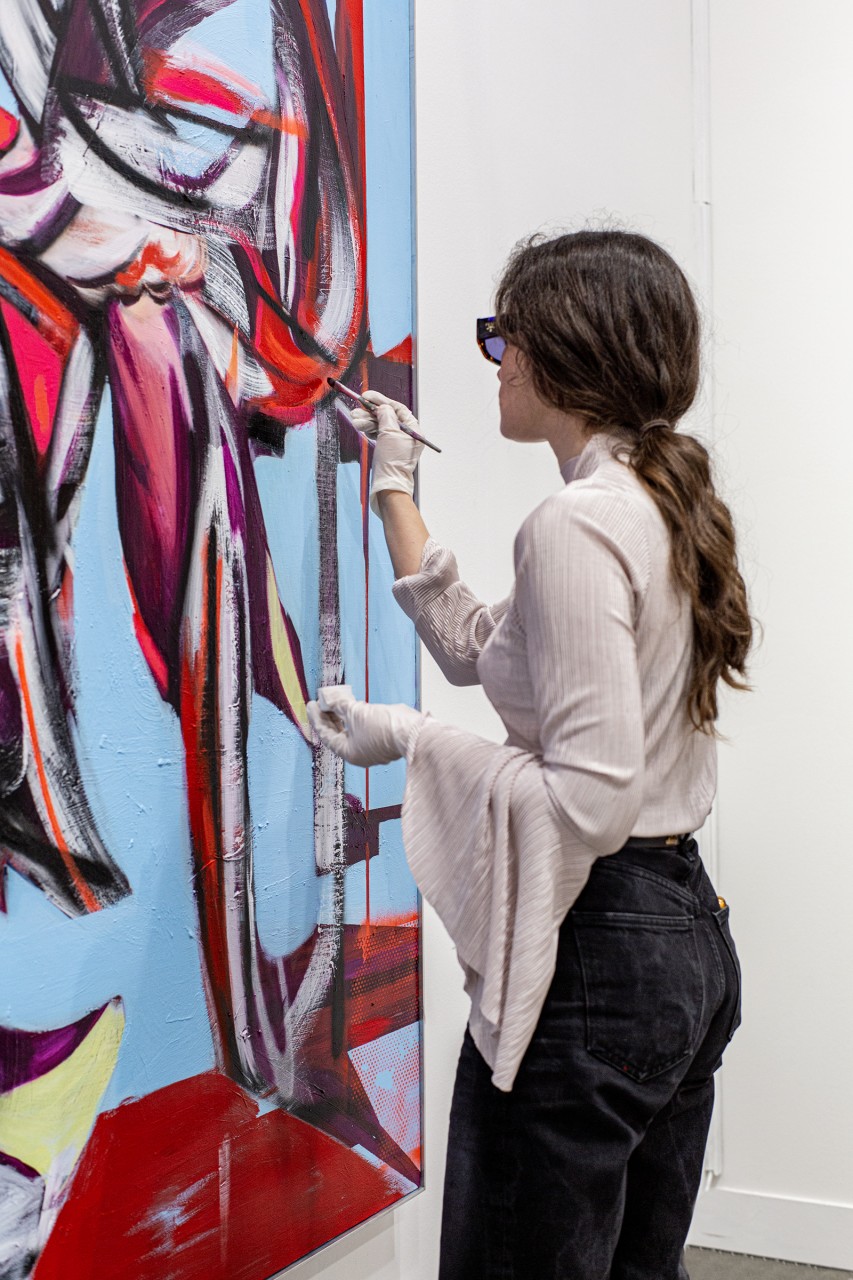
Exhibition view, Romana Londi, « Jetlag: San Bartolomeo », Miart, Milan, 2024. Photo © Gabriele Abbruzzese
Many of Londi’s paintings engage with the temporal dissonances of life lived between the different places of our lives, between the home of our birth and the homes that we build in adulthood, between the familial relationships that we inherit and the fragile bonds we build ourselves. Londi has put the philosophical investigation into the nature of these temporal dissonances into her work because she believes that the rapid advancement in technology has disconnected us from nature and from our environment. ‘Like Courbet, who reconnected to the gestural métier of paint at the advent of photography’, Londi has said, ‘I return to painting gesture as a way to recalibrate what painting is, and what is its enduring strength.’ Hers are works that attest to art’s capacity to act as some kind of compensation for loss, but also something simpler: the assurance that another, and here recuperated through her intensely physiological vernacular of abstraction, has experienced something that we – that I, that all of us – are too experiencing. I believe that Londi’s works, which manage to articulate the sensuous presence of life lived on the fly while documenting the negated traces of what once was, or might continue to exist but without our attention, offers a compelling route out of the distractedness of our increasingly atomized lives. As well as any other artist working today, Londi knows that the most daunting moment is to find ourselves at the threshold of the cave. But more than that, as an artist who recognizes the possibilities and limitations of art at a time of extreme transformation and crisis, she offers us a route through.
— Matthew J. Holman
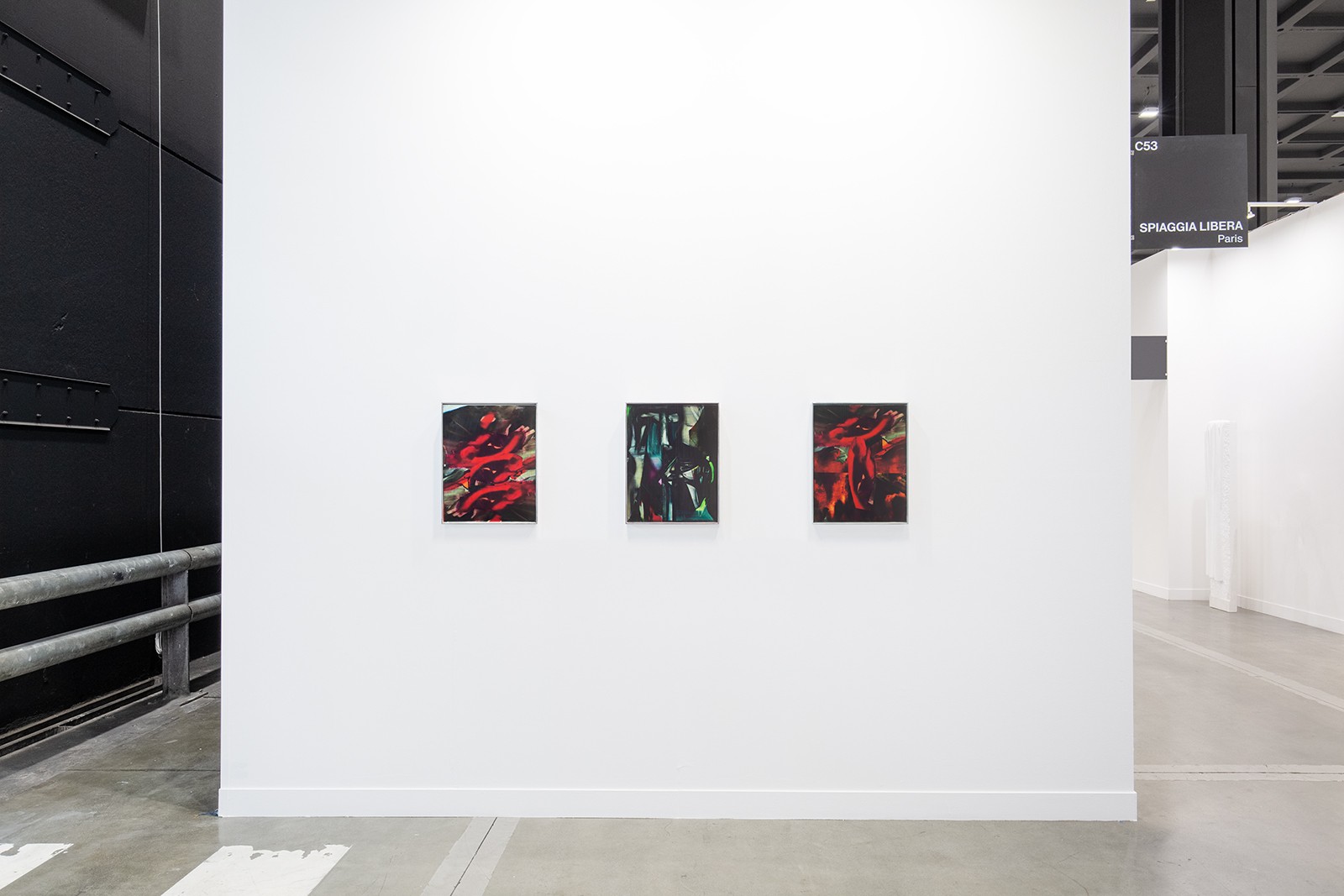
Exhibition view, Romana Londi, « Jetlag: San Bartolomeo », Miart, Milan, 2024. Photo © Gabriele Abbruzzese
Sentient, 2024, oil paint and acrylic on canvas, photochromic film, 50 x 40 cm. Courtesy the artist & Spiaggia Libera, Paris. Photo © Gabriele Abbruzzese
Sentient, 2024, oil paint and acrylic on canvas, photochromic film, 50 x 40 cm. Courtesy the artist & Spiaggia Libera, Paris. Photo © Gabriele Abbruzzese
